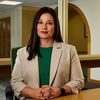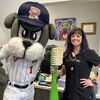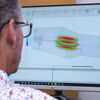Processing Your Payment
Please do not leave this page until complete. This can take a few moments.
- News
-
Editions
View Digital Editions
Biweekly Issues
- Nov. 17, 2025
- November 03, 2025
- October 20, 2025
- October 6, 2025
- September 22, 2025
- September 8, 2025
- + More
Special Editions
- Lists
- Viewpoints
-
Our Events
Event Info
Award Honorees
- Calendar
- Biz Marketplace
MIT professor Robert Langer reflects on struggles early in his career
MIT professor Robert Langer has often been called a modern-day Thomas Edison. Both are known as serial entrepreneurs who have made life-changing devices.
I had interviewed Langer several times when I lived in Cambridge, Mass., and knew he's been credited with helping start a couple dozen companies, has had more than 250 companies license or sublicense his inventions, and has more than 1,000 patents issued or pending. But only recently did I learn he was once a struggling entrepreneur with a great idea no one wanted.
Langer, 67, spoke about several of his key inventions, along with early career setbacks, at a recent science writer's convention in Cambridge.
He studied chemical engineering at both Cornell University and then MIT. When he graduated from MIT, there was a gas shortage, so like many of his classmates he applied to oil companies.
“I got 20 job offers, four from Exxon alone,” he said. “I realized I did not want to do that.”
So he developed a new chemistry curriculum at a school in Cambridge, and wrote to 40 colleges to see if he could get a position teaching. “None wrote back,” he said, adding that he also was ignored by the many hospitals and medical schools he had contacted.
Then, like many entrepreneurs, he met someone who would change the course of his career: Dr. Judah Folkman, known for his research on how a tumor attracts blood vessels to nourish itself.
“A colleague told me Dr. Folkman sometimes hires unusual people,” Langer said. Folkman hired him in the mid-1970s, and Langer became the only chemist in his laboratory at Harvard Medical School.
He then began studying new materials and applying them to medicine, something he is famous for today. But at the time, older scientists told him they didn't believe anything he said.
“My career in the beginning wasn't good,” Langer said.
MIT subsequently hired him in its nutrition and food science department, where the department head told him to look for another job.
“My first nine grant applications were rejected,” he said.
But he persisted, and as the chemistry, biology and new materials disciplines began to merge, Langer became famous for his work. He said more than 100 products from his lab are now either in clinical trials or approved.
One is an intelligent drug-delivery system that can dole out doses of different medicines at the precise time they will best benefit patients. That discovery turned into a company called Microchips Biotech Inc. that was started by one of Langer's postdoctoral researchers. It now has a prototype pharmacy-on-a-chip the size of a quarter that can be implanted into patients, where electricity releases drugs stored in wells on the chip. The first trial in humans was published in the scientific journal Science Translational Medicine two years ago.
The technology has broad applications to get patients to take their medicine. Langer talked about how three years ago Bill Gates, who founded Microsoft, came into his laboratory and awarded him a four-year, $12.9 million grant to develop personal fertility control systems for the developing world, which is a focus of the Bill and Melinda Gates Foundation.
“We needed an implant to last 17 years, not just three years,” he said. “Women can turn it on and off as they want. There are 200 wells with fertility drugs, each of which has a one-month supply.”
The Langer Lab's inventions have found their way into tissue-engineering applications to make bone, cartilage and liver cells and into treatments for brain injuries.
“When I first wrote grants on tissue engineering, people said it wouldn't work,” he said. “I was very depressed when all these things happened in the 1970s. But bioengineering and chemistry can relieve suffering and prolong life. I believed in it and the science was right so I kept working on it.”
And now, if he even has to make any calls, they get answered.
Mainebiz web partners

The Giving Guide
The Giving Guide helps nonprofits have the opportunity to showcase and differentiate their organizations so that businesses better understand how they can contribute to a nonprofit’s mission and work.
Learn More
Work for ME
Work for ME is a workforce development tool to help Maine’s employers target Maine’s emerging workforce. Work for ME highlights each industry, its impact on Maine’s economy, the jobs available to entry-level workers, the training and education needed to get a career started.
Learn More
Groundbreaking Maine
Whether you’re a developer, financer, architect, or industry enthusiast, Groundbreaking Maine is crafted to be your go-to source for valuable insights in Maine’s real estate and construction community.
Learn more-
The Giving Guide
The Giving Guide helps nonprofits have the opportunity to showcase and differentiate their organizations so that businesses better understand how they can contribute to a nonprofit’s mission and work.
-
Work for ME
Work for ME is a workforce development tool to help Maine’s employers target Maine’s emerging workforce. Work for ME highlights each industry, its impact on Maine’s economy, the jobs available to entry-level workers, the training and education needed to get a career started.
-
Groundbreaking Maine
Whether you’re a developer, financer, architect, or industry enthusiast, Groundbreaking Maine is crafted to be your go-to source for valuable insights in Maine’s real estate and construction community.
ABOUT
NEW ENGLAND BUSINESS MEDIA SITES
No articles left
Get access now
In order to use this feature, we need some information from you. You can also login or register for a free account.
By clicking submit you are agreeing to our cookie usage and Privacy Policy
Already have an account? Login
Already have an account? Login
Want to create an account? Register
Get access now
In order to use this feature, we need some information from you. You can also login or register for a free account.
By clicking submit you are agreeing to our cookie usage and Privacy Policy
Already have an account? Login
Already have an account? Login
Want to create an account? Register







Comments